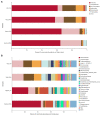Wild and Captive Environments Drive the Convergence of Gut Microbiota and Impact Health in Threatened Equids
- PMID: 35814657
- PMCID: PMC9259803
- DOI: 10.3389/fmicb.2022.832410
Wild and Captive Environments Drive the Convergence of Gut Microbiota and Impact Health in Threatened Equids
Abstract
To explore how the living environment influences the establishment of gut microbiota in different species, as well as the extent to which changes in the living environment caused by captive breeding affect wildlife's gut microbiota and health, we used 16S rRNA gene amplicon sequencing and shotgun metagenomic sequencing to compare the gut microbiome of two species of threatened equids, the Przewalski's Horse and the Asian wild ass, in the wild and captivity. The results revealed that different species of Equidae living in the same environment showed remarkable convergence of gut microflora. At the same time, captive populations exhibited significantly "unhealthy" microbiota, such as low Alpha diversity, high levels of potentially pathogenic bacteria and biomarkers of physical or psychological disease, and enrichment of microbial functions associated with exogenous exposure and susceptibility, implying that the artificial environment created by captivity may adversely impact the health of wildlife to some extent. Our findings demonstrate the importance of the environmental factors for the establishment of gut microbiota and host health and provide new insights into the conservation of wildlife in captivity from the perspective of the microbiome.
Keywords: equid; gut microbiota; health; microbiome convergence; sympatry; wild and captive.
Copyright © 2022 Zhou, Tang, Yan, Jia, Xiong, Shang, Shao, Zhang, Wang, He, Hu and Zhang.
Conflict of interest statement
The authors declare that the research was conducted in the absence of any commercial or financial relationships that could be construed as a potential conflict of interest.
Figures






Similar articles
-
Gut Microbiomes of Endangered Przewalski's Horse Populations in Short- and Long-Term Captivity: Implication for Species Reintroduction Based on the Soft-Release Strategy.Front Microbiol. 2020 Mar 12;11:363. doi: 10.3389/fmicb.2020.00363. eCollection 2020. Front Microbiol. 2020. PMID: 32226419 Free PMC article.
-
Unraveling the distinctive gut microbiome of khulans (Equus hemionus hemionus) in comparison to their drinking water and closely related equids.Sci Rep. 2025 Jan 22;15(1):2767. doi: 10.1038/s41598-025-87216-z. Sci Rep. 2025. PMID: 39843625 Free PMC article.
-
Comparison of the gut microbiota composition between the wild and captive Tibetan wild ass (Equus kiang).J Appl Microbiol. 2019 Jun;126(6):1869-1878. doi: 10.1111/jam.14240. Epub 2019 Apr 3. J Appl Microbiol. 2019. PMID: 30825354 Free PMC article.
-
Global landscape of gut microbiome diversity and antibiotic resistomes across vertebrates.Sci Total Environ. 2022 Sep 10;838(Pt 2):156178. doi: 10.1016/j.scitotenv.2022.156178. Epub 2022 May 23. Sci Total Environ. 2022. PMID: 35618126 Review.
-
Captivity and Animal Microbiomes: Potential Roles of Microbiota for Influencing Animal Conservation.Microb Ecol. 2023 Apr;85(3):820-838. doi: 10.1007/s00248-022-01991-0. Epub 2022 Mar 22. Microb Ecol. 2023. PMID: 35316343 Review.
Cited by
-
Mucosal immune responses and intestinal microbiome associations in wild spotted hyenas (Crocuta crocuta).Commun Biol. 2025 Jun 13;8(1):924. doi: 10.1038/s42003-025-08243-0. Commun Biol. 2025. PMID: 40514454 Free PMC article.
-
Editorial: Community series in the wildlife gut microbiome and its implication for conservation biology, volume II.Front Microbiol. 2023 Dec 20;14:1329928. doi: 10.3389/fmicb.2023.1329928. eCollection 2023. Front Microbiol. 2023. PMID: 38173679 Free PMC article. No abstract available.
-
Unstable pathogen profile in spotted seal (Phoca largha) gut microbiota and limited turnover with habitat microbiome.Int Microbiol. 2025 Aug;28(6):1183-1195. doi: 10.1007/s10123-024-00615-6. Epub 2024 Nov 12. Int Microbiol. 2025. PMID: 39532804
-
Dynamic distribution of gut microbiota in cattle at different breeds and health states.Front Microbiol. 2023 Feb 16;14:1113730. doi: 10.3389/fmicb.2023.1113730. eCollection 2023. Front Microbiol. 2023. PMID: 36876099 Free PMC article.
-
Updating conservation metagenomics on the gut microbiome of threatened mammals.iScience. 2025 Jun 25;28(7):113000. doi: 10.1016/j.isci.2025.113000. eCollection 2025 Jul 18. iScience. 2025. PMID: 40687781 Free PMC article. Review.
References
-
- Blyton M. D. J., Soo R. M., Whisson D., Marsh K. J., Pascoe J., Le Pla M., et al. . (2019). Faecal inoculations alter the gastrointestinal microbiome and allow dietary expansion in a wild specialist herbivore, the koala. Anim. Microbiome 1:6. doi: 10.1186/s42523-019-0008-0, PMID: - DOI - PMC - PubMed
LinkOut - more resources
Full Text Sources
Miscellaneous

